Blog post by: Eye Physicians of Long Beach
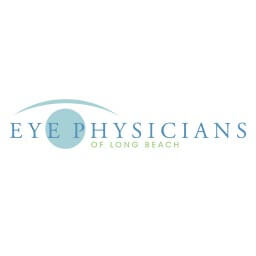
Do you suffer from dry or itchy eyes? You may be one of the millions of Americans living with the symptoms of dry eye syndrome. Although millions of people suffer from dry eye syndrome, it doesn’t mean there isn’t hope for relief.
Depending on what is causing your dry eyes, there are treatment options available, including an in-office procedure known as LipiFlow that is available at Eye Physicians of Long Beach.
What is dry eye syndrome?
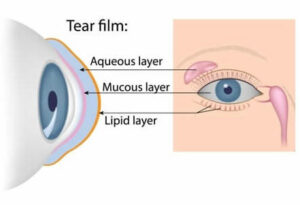
In most cases, dry eye syndrome occurs when you aren’t producing enough tears or the tears being produced are low-quality and are not hydrating the eyes sufficiently. Human tears are made up of three different components: water, oil, and a mucin layer. If any of these components are missing, it causes the tears to not coat the surface of the eye correctly.
Dry eye can happen because of environment, genetics, increased screen time, or even due to not blinking frequently enough. When you have dry eye syndrome, it’s important to identify the underlying cause to treat it properly. For many people that have dry eye syndrome, they may also suffer from Meibomian Gland Dysfunction (MGD). MGD is one of the leading causes of dry eye syndrome.
What is Meibomian Gland Dysfunction?
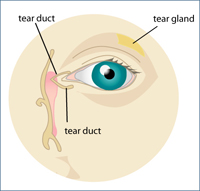
When they are healthy, the meibomian glands inside the eyelids produce a thin oil called meibum. Meibomian Gland Dysfunction (MGD) occurs when meibomian glands become blocked, and these oils are unable to exit the eyelids and coat the surface of the eye.
Meibum is a very important part of tear production because it helps to prevent tear evaporation, keeping the eyes moist and comfortable. If the gland secretions inside the eyelids thicken, it causes a blockage of the meibomian glands. This leads to poor quality tear film, as well as uncomfortable symptoms of dry eye syndrome. Without treatment, MGD will only cause more symptoms of discomfort.
What is LipiFlow?
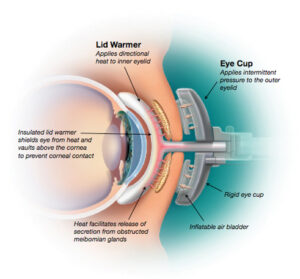
If you suffer from MGD and dry eye syndrome, LipiFlow may be an effective treatment option. The first step is to set up a dry eye evaluation with a specialist. The evaluation will include testing and examination of your eyes to determine if you would be a good candidate for LipiFlow.
The specialist will take a Lipiscan, which is a non-invasive, painless photo taken of your eyelids. This high-definition photograph allows your specialist to look for signs of meibomian gland blockage, which is a common sign of Meibomian Gland Dysfunction. They will also look for any thickening, loss, and shortening in the eyelid picture.
If you are deemed a good fit for LipiFlow, you’ll have the procedure at your eye doctor’s office. LipiFlow uses both warmth and gentle pressure (thermal pulse technology) to treat MGD. It unblocks meibomian glands due to Meibomian Gland Dysfunction, allowing them to produce healthy oils and restore oil production in the eyes.
How does LipiFlow work?
During the LipiFlow treatment, you’ll have sterile “activators” carefully placed over and under your eyelids. The activators protect your eyes and act as a shield from the gentle heat and pressure that occurs during the treatment. After putting the activators into place, your treatment can start. Treatment begins with the LipiFlow system applying warmth to the inner eyelids, this will help to liquify any thick oils that have accumulated in the meibomian glands.
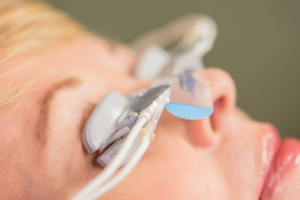
After gland secretions are liquified, a therapeutic massage is then applied to your eyelids. This helps to release thick oil from the blocked meibomian glands, stimulating secretion. Once glands have been cleaned and are more open, the glands can start to produce and secrete a healthier, thinner oil over time. This leads to a healthier tear film and fewer symptoms of dry eye syndrome.
By allowing the meibomian glands to regulate, it also minimizes the rate that glands are lost. This is important because once meibomian glands are lost, they are gone for good and cannot come back.
Is LipiFlow FDA approved?
Yes, LipiFlow is an approved medical device by the Food and Drug Administration. Though it is FDA approved, LipiFlow is not right for everyone. Patients that have recently had eye surgery or injuries, currently have a severe eye infection, or any eye surface abnormalities may not qualify for LipiFlow.
It’s important to discuss all risks and possible benefits of LipiFlow treatment with your eye doctor before undergoing the procedure. If you are not a good candidate for LipiFlow, talk to your eye doctor about other possible treatment options instead.
How long does a LipiFlow treatment take?
The actual procedure is very fast, taking only about twelve minutes. There is no pain during or after having LipiFlow, but you may experience slight discomfort during the first hour – this will go away on its own.
Are the results after LipiFlow immediate?
Although LipiFlow works quite well for patients with Meibomian Gland Dysfunction, it does take time before you start seeing results. This is because the meibomian glands need time before they can start to produce the oily protective film again.
For most, it usually takes about 6-8 weeks after treatment before patients see maximum improvement in their symptoms. The good news is that many patients do experience a significant amount of relief after having LipiFlow treatment.
Do the results from LipiFlow last forever?
No, the results from LipiFlow do not last forever. They are only temporary. The reduction of symptoms from MGD will usually last about 12 months before they start to return.

LipiFlow is safe to have repeated. How often you need treatments repeated depends on your eyes. Some patients may only need treatments every two years, while others may benefit from LipiFlow treatments every eight to twelve months. This is something that your eye doctor will determine based on how your eyes respond to the LipiFlow treatment.
Think that LipiFlow may be right for you? Schedule an appointment at Eye Physicians of Long Beach in Long Beach, CA to discuss this revolutionary treatment option for dry eye and Meibomian Gland Dysfunction!
